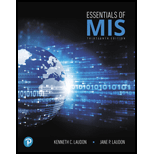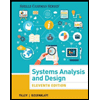
Essentials of MIS (13th Edition)
13th Edition
ISBN: 9780134802756
Author: Kenneth C. Laudon, Jane Laudon
Publisher: PEARSON
expand_more
expand_more
format_list_bulleted
Concept explainers
Question
Chapter 10, Problem 14CTP
Program Plan Intro
E-commerce:
- E-commerce denotes a commerce via internet or online facilities.
- It denotes buying or selling of products online.
- The areas of e-commerce includes:
- Online Retailing
- Electric markets
- Online Auctions
- It provides online shopping for retail sales direct to consumers via web sites.
- It uses demographic data through social media and web contacts.
- It engages in retail for launching new services and products.
- It has online financial exchanges for trading and concurrency exchanges.
Features of e-commerce:
The eight unique feature of e-commerce is shown below:
- Ubiquity:
- Internet technology is accessible to the customer everywhere.
- Global reach:
- It displays that e-commerce grows to each part of the world.
- It also allows commercial transaction among national boundaries
- Universal standards:
- It is also called as universal standards.
- These standards are used for organizing e-commerce business that is exchanged across the world.
- Richness
- Video, audio, and text messages are possible in these features.
- These features are merged into single marketing message and consumer experience.
- Video, audio, and text messages are possible in these features.
- Interactivity:
- This features works by communication with the user. The communication is done by two-way method that is the consumer and supplier.
- Information density:
- Here the technology decreases the information costs.
- It improves the currency, accuracy and quality.
- Personalization/Customization:
- This feature is used to deliver the personalized message to individual and also to groups.
- Social technology:
- It supports the content generation and social networking.
Program Plan Intro
E-commerce:
- E-commerce denotes a means of commerce via internet or online facilities.
- It denotes buying or selling of products online.
- The areas of e-commerce includes:
- Online Retailing
- Electric markets
- Online Auctions
- It provides online shopping for retail sales direct to consumers via web sites.
- It uses demographic data through social media and web contacts.
- It engages in pretail for launching new services and products.
- It has online financial exchanges for trading and concurrency exchanges.
Features of e-commerce:
The eight unique feature of e-commerce is shown below:
- Ubiquity:
- Internet technology is accessible to the customer everywhere.
- Global reach:
- It displays that e-commerce grows to each part of the world.
- It also allows commercial transaction among national boundaries
- Universal standards:
- It is also called as universal standards.
- These standards are used for organizing e-commerce business that is exchanged across the world.
- Richness
- Video, audio, and text messages are possible in these features.
- These features are merged into single marketing message and consumer experience.
- Video, audio, and text messages are possible in these features.
- Interactivity:
- This features works by communication with the user. The communication is done by two-way method that is the consumer and supplier.
- Information density:
- Here the technology decreases the information costs.
- It improves the currency, accuracy and quality.
- Personalization/Customization:
- This feature is used to deliver the personalized message to individual and also to groups.
- Social technology:
- It supports the content generation and social networking.
Program Plan Intro
E-commerce:
- E-commerce denotes a means of commerce via internet or online facilities.
- It denotes buying or selling of products online.
- The areas of e-commerce includes:
- Online Retailing
- Electric markets
- Online Auctions
- It provides online shopping for retail sales direct to consumers via web sites.
- It uses demographic data through social media and web contacts.
- It engages in pretail for launching new services and products.
- It has online financial exchanges for trading and concurrency exchanges.
Features of e-commerce:
The eight unique feature of e-commerce is shown below:
- Ubiquity:
- Internet technology is accessible to the customer everywhere.
- Global reach:
- It displays that e-commerce grows to each part of the world.
- It also allows commercial transaction among national boundaries
- Universal standards:
- It is also called as universal standards.
- These standards are used for organizing e-commerce business that is exchanged across the world.
- Richness
- Video, audio, and text messages are possible in these features.
- These features are merged into single marketing message and consumer experience.
- Video, audio, and text messages are possible in these features.
- Interactivity:
- This features works by communication with the user. The communication is done by two-way method that is the consumer and supplier.
- Information density:
- Here the technology decreases the information costs.
- It improves the currency, accuracy and quality.
- Personalization/Customization:
- This feature is used to deliver the personalized message to individual and also to groups.
- Social technology:
- It supports the content generation and social networking.
Expert Solution & Answer
Want to see the full answer?
Check out a sample textbook solution
Students have asked these similar questions
4. |z + 5 - 5i| = 7
14.
dz,
C: |z❘
C: |z❘ = 0.6
ze² - 2iz
H
14.
dz,
C: |z❘
C: |z❘ = 0.6
ze² - 2iz
H
Chapter 10 Solutions
Essentials of MIS (13th Edition)
Ch. 10.2 - Prob. 1CQ1Ch. 10.2 - Prob. 2CQ1Ch. 10.2 - Prob. 3CQ1Ch. 10.2 - Prob. 4CQ1Ch. 10.3 - Prob. 1CQ2Ch. 10.3 - Prob. 2CQ2Ch. 10.3 - Prob. 3CQ2Ch. 10.3 - Prob. 4CQ2Ch. 10 - Prob. 1IQCh. 10 - Prob. 2IQ
Ch. 10 - Prob. 3IQCh. 10 - Prob. 4IQCh. 10 - Prob. 5IQCh. 10 - Prob. 6IQCh. 10 - Prob. 7IQCh. 10 - Prob. 1RQCh. 10 - Prob. 2RQCh. 10 - Prob. 3RQCh. 10 - Prob. 4RQCh. 10 - Prob. 5RQCh. 10 - Prob. 6RQCh. 10 - Prob. 7DQCh. 10 - Prob. 8DQCh. 10 - Prob. 9DQCh. 10 - Prob. 10HMPCh. 10 - Prob. 11HMPCh. 10 - Prob. 14CTPCh. 10 - Prob. 15CSQCh. 10 - Prob. 16CSQCh. 10 - Prob. 17CSQCh. 10 - Prob. 18MLMCh. 10 - Prob. 19MLM
Knowledge Booster
Learn more about
Need a deep-dive on the concept behind this application? Look no further. Learn more about this topic, computer-science and related others by exploring similar questions and additional content below.Similar questions
arrow_back_ios
SEE MORE QUESTIONS
arrow_forward_ios
Recommended textbooks for you
 Principles of Information Systems (MindTap Course...Computer ScienceISBN:9781285867168Author:Ralph Stair, George ReynoldsPublisher:Cengage Learning
Principles of Information Systems (MindTap Course...Computer ScienceISBN:9781285867168Author:Ralph Stair, George ReynoldsPublisher:Cengage Learning Principles of Information Systems (MindTap Course...Computer ScienceISBN:9781305971776Author:Ralph Stair, George ReynoldsPublisher:Cengage Learning
Principles of Information Systems (MindTap Course...Computer ScienceISBN:9781305971776Author:Ralph Stair, George ReynoldsPublisher:Cengage Learning Fundamentals of Information SystemsComputer ScienceISBN:9781337097536Author:Ralph Stair, George ReynoldsPublisher:Cengage Learning
Fundamentals of Information SystemsComputer ScienceISBN:9781337097536Author:Ralph Stair, George ReynoldsPublisher:Cengage Learning Systems Analysis and Design (Shelly Cashman Serie...Computer ScienceISBN:9781305494602Author:Scott Tilley, Harry J. RosenblattPublisher:Cengage Learning
Systems Analysis and Design (Shelly Cashman Serie...Computer ScienceISBN:9781305494602Author:Scott Tilley, Harry J. RosenblattPublisher:Cengage Learning

Principles of Information Systems (MindTap Course...
Computer Science
ISBN:9781285867168
Author:Ralph Stair, George Reynolds
Publisher:Cengage Learning


Principles of Information Systems (MindTap Course...
Computer Science
ISBN:9781305971776
Author:Ralph Stair, George Reynolds
Publisher:Cengage Learning

Fundamentals of Information Systems
Computer Science
ISBN:9781337097536
Author:Ralph Stair, George Reynolds
Publisher:Cengage Learning


Systems Analysis and Design (Shelly Cashman Serie...
Computer Science
ISBN:9781305494602
Author:Scott Tilley, Harry J. Rosenblatt
Publisher:Cengage Learning